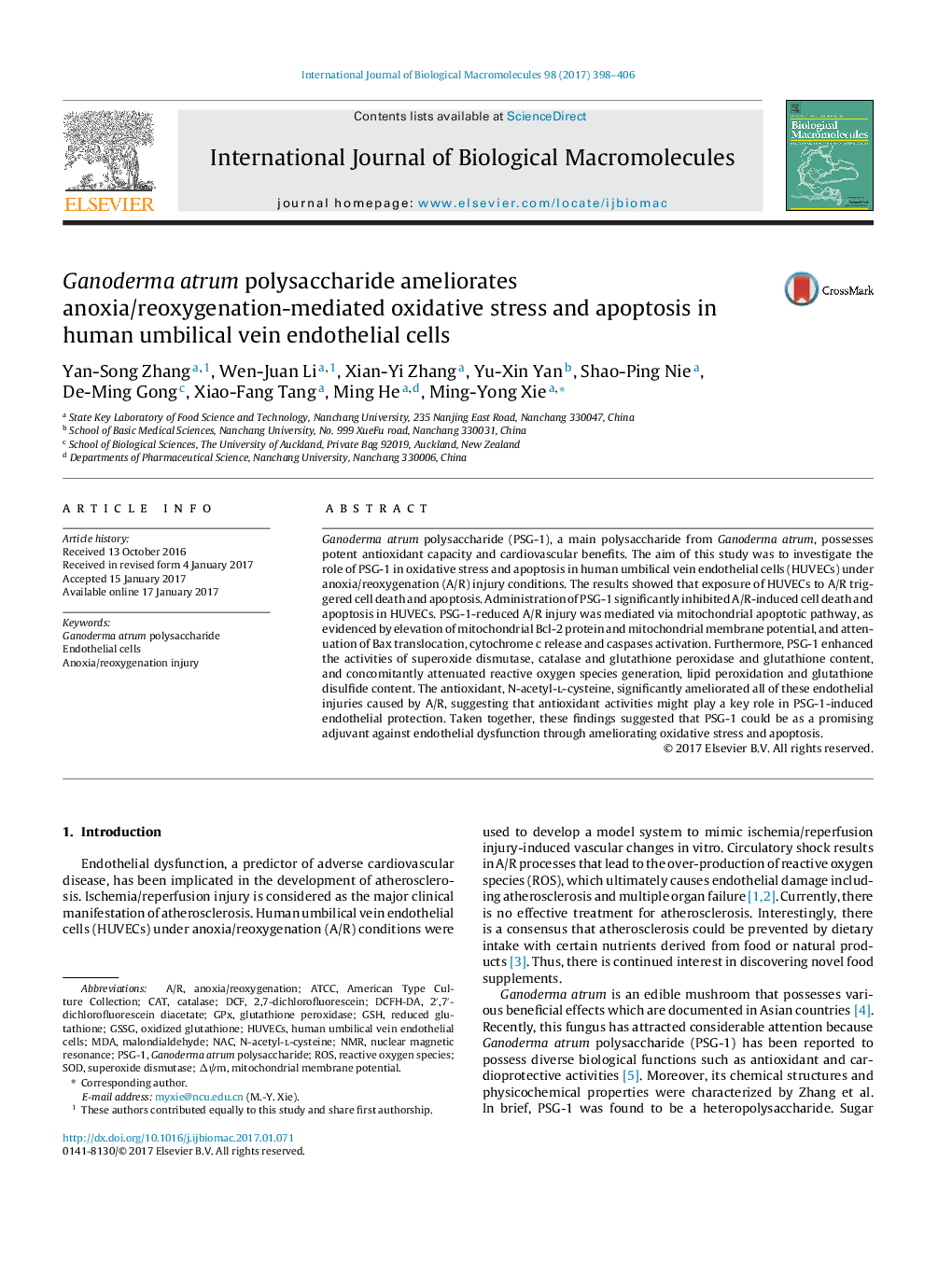| Article ID | Journal | Published Year | Pages | File Type |
|---|---|---|---|---|
| 5512288 | International Journal of Biological Macromolecules | 2017 | 9 Pages |
â¢PSG-1 protects human umbilical vein cells (HUVECs) against A/R-mediated oxidative stress and apoptosis.â¢PSG-1-reduced A/R injury was mediated via the reduction of mitochondrial apoptotic pathway.â¢PSG-1 enhances enzymatic and non-enzymatic free radical scavenging abilities in HUVECs subjected to A/R.â¢Antioxidant activities play a key role in PSG-1-induced cell protection.
Ganoderma atrum polysaccharide (PSG-1), a main polysaccharide from Ganoderma atrum, possesses potent antioxidant capacity and cardiovascular benefits. The aim of this study was to investigate the role of PSG-1 in oxidative stress and apoptosis in human umbilical vein endothelial cells (HUVECs) under anoxia/reoxygenation (A/R) injury conditions. The results showed that exposure of HUVECs to A/R triggered cell death and apoptosis. Administration of PSG-1 significantly inhibited A/R-induced cell death and apoptosis in HUVECs. PSG-1-reduced A/R injury was mediated via mitochondrial apoptotic pathway, as evidenced by elevation of mitochondrial Bcl-2 protein and mitochondrial membrane potential, and attenuation of Bax translocation, cytochrome c release and caspases activation. Furthermore, PSG-1 enhanced the activities of superoxide dismutase, catalase and glutathione peroxidase and glutathione content, and concomitantly attenuated reactive oxygen species generation, lipid peroxidation and glutathione disulfide content. The antioxidant, N-acetyl-l-cysteine, significantly ameliorated all of these endothelial injuries caused by A/R, suggesting that antioxidant activities might play a key role in PSG-1-induced endothelial protection. Taken together, these findings suggested that PSG-1 could be as a promising adjuvant against endothelial dysfunction through ameliorating oxidative stress and apoptosis.
Graphical abstractProposed model for the cellular mechanisms of PSG-1-ameliorated ROS generation and apoptosis of HUVECS in response to anoxia/reoxygenation (A/R). A/R resulted in markedly increased ROS generation and apoptosis, triggering cellular damage in HUVECs. These changes were in association with the loss of ÎÏm; the release of cytochrome c (Cyto c) from mitochondria into the cytosol; and the activation of caspase-3 and caspase-9. The generation of ROS could be diminished by the antioxidant defense systems including enzymatic (SOD, CAT, and GPx) and non-enzymatic (GSH and GSSG) free radical scavenging systems. PSG-1 significantly inhibited ROS generation, mitochondrial changes, caspase activation and apoptosis. The effects of PSG-1-ameliorated ROS generation and apoptosis coincided with the increase of mitochondrial Bcl-2 protein and ÎÏm, the inhibition of Bax translocation, Cyto c release and caspases activation. Moreover, these protective effects of PSG-1 were linked to the enhancement of enzymatic and non-enzymatic free radical scavenging systems. Together, PSG-1 could ameliorate A/R-mediated endothelial cell damage via attenuation of apoptosis and ROS generation mediated by its effects on modification of redox system.
